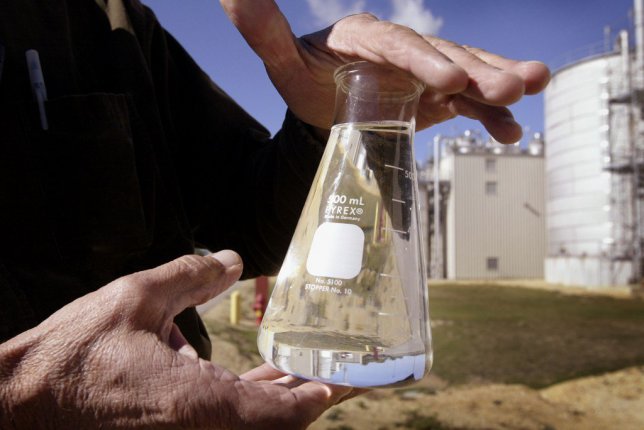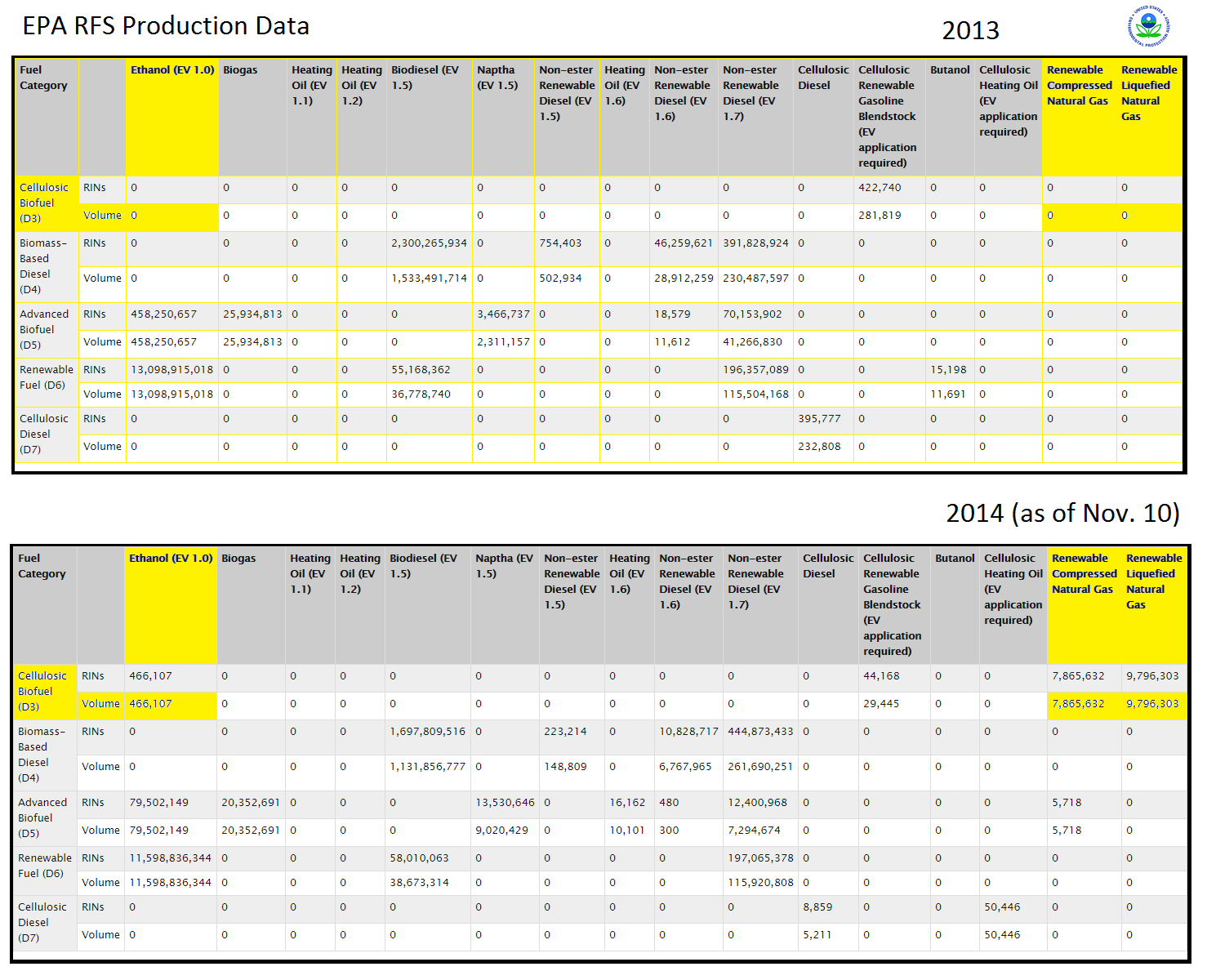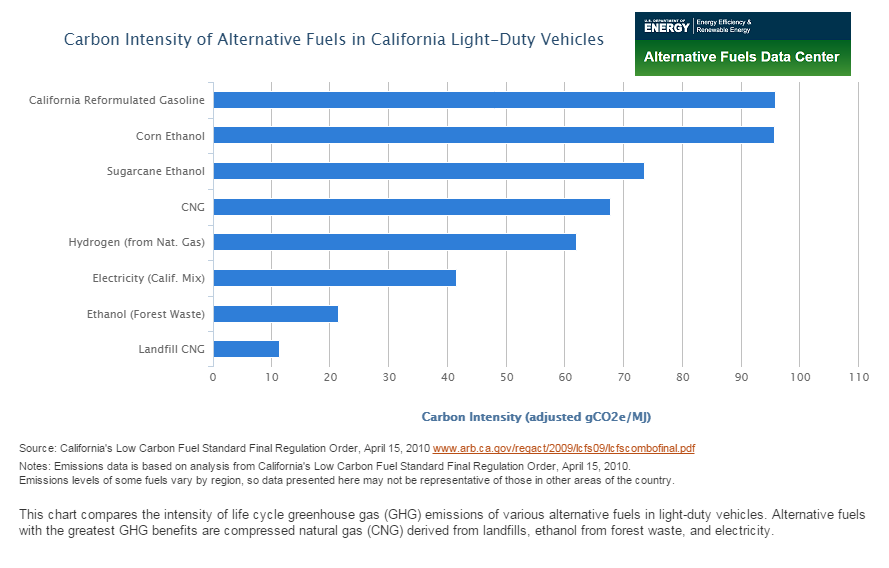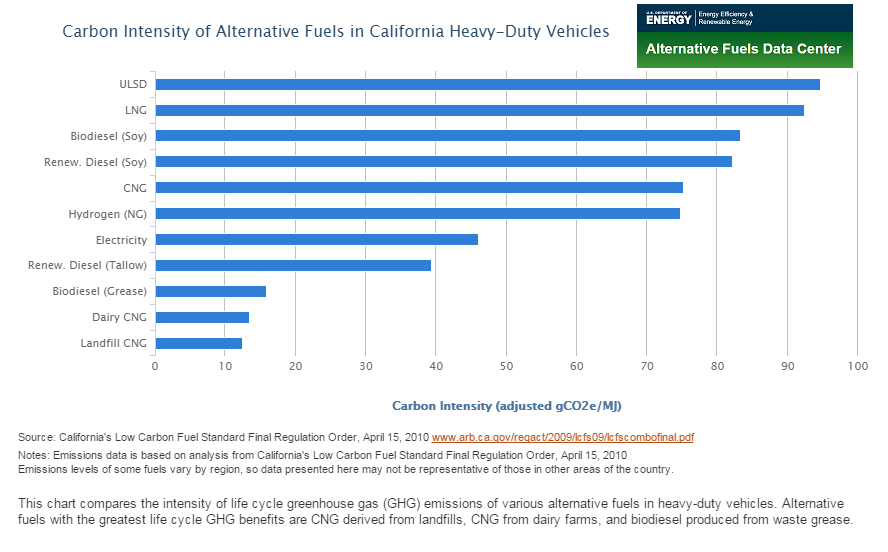The EPA has long promoted cellulosic ethanol as the future of biofuels, but technical challenges have kept production far below targets. A recent rule change allows RNG, renewable natural gas, to qualify as cellulosic biofuel even though RNG is not cellulosic, but this helps EPA appear to be meeting their goals.
RNG growth has been dramatic and is the lowest carbon vehicle fuel available today. Perhaps the EPA should be promoting a Renewable Gas Standard instead of a Renewable Fuel Standard.
In 2013 production of cellulosic ethanol was effectively zero, even though the legislated target volume for 2013 was 1 billion gallons. In August 2013 EPA reduced the target to 6 million gallons, and again reduced the target retroactively to 810,185 gallons, less than 1 million. By all accounts this represents a complete failure of the cellulosic ethanol program. In July 2014 the EPA revised the cellulosic biofuel rules to allow RNG to be categorized as cellulosic.
The RFS production data tells the story. In 2013, cellulosic biofuel production was nearly zero. In 2014, a small amount of cellulosic ethanol was produced, but all a sudden there are 17.5 million gallons of renewable CNG and LNG. The appearance of RNG was purely a function of the rule change in July that allowed already existing (unsubsidized) production of renewable CNG/LNG to qualify. The production of cellulosic ethanol is barely half of the already modest target despite extensive federal support.
EPA uses five RIN D-codes (D3, D4, D5, D6 and D7) to define biofuels under the RFS. D3 and D7 are for cellulosic biofuels with a GHG reduction requirement of 60%; D6 is for corn ethanol (GHG reduction 20%); D4 is for biomass-based diesel (50% GHG reduction); and D5 is for advanced biofuels, including sugarcane ethanol and biogas (50% GHG reduction).
Ethanol fuels have been subject to a great deal of criticism for both environmental and engineering reasons. Ethanol is traditionally made from sugars fermented into alcohol. The sugars are derived from agricultural crops, predominantly corn in the USA and sugarcane in Brazil, the world’s two largest ethanol producing countries. Since the use of food crops for fuel competes with food production and raises food prices there has been much effort to develop alternative pathways to produce (cellulosic) ethanol from non-food crops such as grasses, wood and waste.
The problem with cellulosic ethanol is that it is quite challenging to break down cellulose because it is the part of a plant that is meant to be tough. Cellulosic ethanol producers have struggled to find energy and cost efficient means of accomplishing the task and many have gone bankrupt, such as KiOR recently.
There are significant engineering challenges in using ethanol as well, the biggest being that ethanol is hydroscopic, meaning that it attracts and absorbs water. Water build up can create corrosion in tanks, fuel lines and engines and can create phase separation of the fuel itself causing engine performance issues. Ethanol also breaks down certain types of polymers and rubber sealants, as well as attacking iron, copper and brass and in some circumstances ethanol has been thought to react with fiberglass fuel tanks creating sludge build up.
Older engines can be ruined by the use of ethanol, though modern engines use materials that are resistant to such failures. A properly designed engine can run on pure (neat) ethanol, though attention must be made to manufacturer’s instructions regarding appropriate fuel choice.
Ethanol blends in gasoline up to 10%, known as E10, are approved for general use in the USA and are common today, but blending ethanol above 10% is a heated debate. The 10% threshold is known as the “blend wall” and current ethanol production currently lies at the right at that level. Ethanol producers and advocates are actively lobbying the government to approve blends of E15 and E85 (15% and 85%). Petroleum interests are actively opposed to increased ethanol blends, for obvious reasons, as they are trying to protect market share for their product.
Consumers, vehicle manufactures, fuel distributors and retailers are caught in the middle. E15 would be marketed for general use and there is a great deal of concern that increased ethanol ratios will create major maintenance problems. As it stands today E10 is not used in boating, is discouraged for use in small engines such as lawn mowers and chain saws, and is not distributed through pipelines due to corrosion issues. Ethanol must be transported separately from gasoline in trucks and blended at the end of the line near the point of distribution.
The vast majority of ethanol produced in the USA is made from corn, which is an intensive crop to cultivate, requiring fertilizers, pesticides and heavy equipment, all of which are based on fossil fuels. This is why life-cycle greenhouse gas emissions from corn ethanol are only marginally lower than for gasoline. GHG emissions from corn ethanol are higher than that of fossil natural gas! Cellulosic ethanol has low GHG emissions in theory, but since there is hardly any actual commercial production it remains a theory.
Renewable natural gas has clear benefits over ethanol. First, RNG is chemically identical to fossil natural gas and can be blended and used without restriction. No engineering modifications must be made to accommodate RNG.
Secondly, RNG is readily producible from non-food resources, particularly waste from landfills, farms, food and sewage. All of the raw materials that have been identified as potential cellulosic ethanol feedstocks could be more easily used as RNG feedstocks. There are many proven pathways for producing RNG, ranging from simple digestion processes up to more complex thermochemical processed suitable for more difficult feedstocks. 10% – 20% of natural gas supplies could be renewable.
While ethanol offers questionable greenhouse gas reductions, RNG is widely regarded as the lowest carbon vehicle fuel available. Data from the Department of Energy’s Alternative Fuels Data Center (shown below) presents the case clearly. Agricultural crops converted into ethanol and biodiesel are barely lower in carbon than gasoline and are higher than fossil natural gas. Landfill CNG has the lowest carbon intensity for both light duty and heavy duty vehicles.
Natural gas is the fastest growing vehicle fuel in use today, it is safe and non-toxic with the lowest emissions of criteria pollutants and also the lowest carbon emissions of any fossil fuel. Renewable natural gas takes carbon emissions down to the lowest possible levels and is a universal fuel that can replace coal and petroleum, ethanol is strictly a blend stock for gasoline that requires substantial engineering upgrades for questionable energy security and environmental outcomes.
It is time to consider a Renewable Gas Standard to replace the failed Renewable Fuel Standard.



